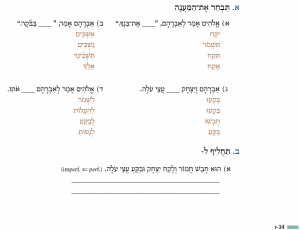This is the second of three questions about the textbook one reader sent us recently. The first post is here; the third post will come tomorrow.
Question:
On page r-34, bottom sentence, what appear to be so-called waw-consecutive perfect [Note that we do not use this term in BBH], e.g., ולקח יצחק ובקע, are seemingly treated as past tense since they are sequential upon חבש. You then ask students to transform into imperfects. From a traditional verbal system perspective, isn’t this confusing? The sentence as currently written is fine in modern Hebrew, but does not work as standard biblical Hebrew.
Answer:
On the waw+perfect used in past temporal contexts (p. r-34): similarly, this is acceptable in Biblical Hebrew even if not very frequent. Our decision to employ waw-prefixed perfect forms that are not irreal mood (traditional “waw-conversive” forms) has both theoretical and pedagogical motivations. Such examples are problematic from the “traditional verbal system perspective” because that perspective is inaccurate. Rather, we refer readers to the theoretical basis of our treatment of the verb now published in John Cook’s authoritative (ahem) volume Time and the Biblical Hebrew Verb (Eisenbrauns, 2012).
The linguistically grounded arguments in Cook’s volume are why we eschew labels such as “waw-conversive,” etc. — our research has not found them to be linguistically defensible. For a challenging example of qatal – qatal – qatal (which, without a larger discourse context is not necessarily different than qatal – w-qatal – w-qatal, since the latter simply lacks the overt subject), see Gen 4.18.
Pedagogically, our decision to utilize a minority sequence at this point in the textbook serves our interest to provide a carefully chosen “graded” sequence towards the complete grammar picture rather than become bogged down in advanced grammar discussions in a first-year textbook.





